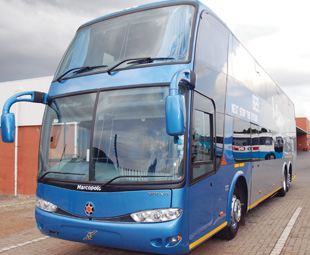Luxury coaches begin comeback

Anxious OEMs are hoping the luxury coaches market will gradually return to form post-SWC slump. FOCUS investigates…
The months leading up to the 2010 Soccer World Cup (SWC) saw bus sales reach all-time highs, particularly in the luxury coach sector, as bus operators augmented their fleets to accommodate the expected 400 000 visitors to South Africa for the event.
In subsequent months, the bus market dampened significantly with sector turnover falling by around 60%. This slowdown in unit sales was expected, however, and reports indicate that much SWC bus stock is currently standing unused by operators. The good news is that Naamsa bus sales figures for June 2011 indicate a 12,5% improvement on June 2010 unit sales, bringing hope to bus OEMs of a gradual return to form within the bus sector.
According to Marius Botha, general manager, Volvo Bus SA, “we have recently received substantial orders for the premiere Volvo double-decker luxury coach, the B12R, built in Brazil and earmarked for intercity and long-distance duty in South Africa. We weren’t expecting anything like the volume of these orders but we’re extremely grateful they’ve come through.”
Botha cites the greater passenger-carrying capacity of the Volvo B12R as a deal-clincher, as well as the need for vehicle replacement in leading long haul luxury coach fleets.
 For Scania’s Winston Muir, the outlook is less rosy. “The luxury coach market has dropped by around 90% since early 2010, but it is important in this instance to differentiate between ‘luxury’ and ‘semi-luxury’ categories. Luxury coaches are equipped with rear-engines, 2+2 seating configurations, full air-conditioning, a toilet and other creature comforts. Semi-luxury coaches have front-mounted engines, 3+2 seating configurations and a single air-conditioner,” he explains.
For Scania’s Winston Muir, the outlook is less rosy. “The luxury coach market has dropped by around 90% since early 2010, but it is important in this instance to differentiate between ‘luxury’ and ‘semi-luxury’ categories. Luxury coaches are equipped with rear-engines, 2+2 seating configurations, full air-conditioning, a toilet and other creature comforts. Semi-luxury coaches have front-mounted engines, 3+2 seating configurations and a single air-conditioner,” he explains.
Muir adds that despite the depressed market, SA Roadlink recently procured five Scania single-decker luxury coaches, which indicates a move away from double-decker luxury coaches amongst leading local coach operators in favour of single-decker derivatives.
“Double-decker coaches are designed for intercity use and don’t have the versatility of single-decker coaches that can be used for cross-border and charter applications. Nor do they hold their resale value as well as single-decker coaches. Translux, for example, recently introduced new single-decker coaches for its intercity routes,” says Muir.
While commuter buses remain the “bread and butter” stock for bus OEMs, luxury coaches carry the “flagship” tag and their deployment in leading coach fleets is important to all bus OEMs. With fleet replacement cycles coming full circle, operators seeking greater efficiencies in their vehicles and the nation continuing to be a tourist hotspot, by mid-2012, sales of new luxury coaches in all likelihood will return to pre-SWC volumes.
Published by
Focus on Transport
focusmagsa




